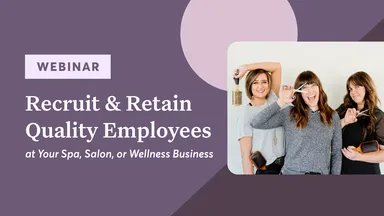
What to Do When Hiring at Your Salon or Spa Is Hard
Last updated: October 7, 2025
Business is "normalizing" in most parts of the US, and spas, salons, and wellness businesses continue to be extremely busy, with high demand for services. That is to say, as busy as they can be. The one common barrier to returning to 2019 revenues? Staffing. There just aren't enough stylists, therapists, technicians, front desk staff, and teachers. In a business model that creates revenue predominately by having direct interaction between an employee and a client, and, in the case of the salon and spa industry, a one-on-one interface, the shrunken labor pool hampers any forward momentum. Two steps forward, one step back. Hiring is on every salon, spa, and wellness business owner's mind.
If you have been thinking that it is just your salon or spa...your neighborhood, village, town, city, or state, don't go there. You are not alone. In fact, it's not just our salon and spa industry; retail, hospitality, and food service, among others, are sharing our pain with hiring and retention. Hospitality and food service are both reportedly down 20% in staffing at the present. It's unfortunate timing because the demand for all these salon and spa services has not coincided with the expected return of our workforces. While even experts can't agree on a simple explanation or cause, it's clear at this point that it is not a problem that will be resolved in a matter of weeks.
Some of the reasons may include:
- Continued personal healthcare challenges or underlying conditions
- Lack of reliable childcare
- Government stimulus and boosted unemployment reducing employment urgency
- Change in intention
Although the first three reasons will eventually fade away, the fourth is more potentially troublesome. The pandemic shutdowns forced us all to step away from the hamster wheel, and that hiatus has given many people the opportunity to rethink their careers and lives. It has likely exacerbated a trend we were already experiencing pre COVID with the onset of the gig economy and more opportunities to create income in a variety of ways—including virtual. Many therapists, technicians, teachers, and support staff were already cutting back their hours or commitment to a single employer.
So, what's the solution? There is no one answer, but here are a few things to consider as we move forward.
1. Culture
Your business must be one that people want to work for. Whether you're in a big city or small town, word travels fast among wellness professionals. If working for you is not rewarding (we're talking beyond a paycheck), you're going to have a lot of trouble recruiting and hiring any new talent to serve clients. Your spa or salon culture needs to appeal to candidates.
2. Speed
Taking three to four days to respond to applicants and job seekers today is akin to bridge burning. This hiring market is moving at warp speed. If you use job boards like Indeed, you may ask applicants to text you in your response template, and you must respond immediately when they do. In many cases, we are seeing the whole process, from online application to initial phone screen, in-person meeting, and job offer compressed into as little as 24 hours! This is not ideal either, but it is the reality of the current situation. You can't merely attract potential candidates, you need to engage with them right away, too.
3. Expectations
When there are disgruntled employees, it is often a result of their feeling that they are not properly communicated with (true 80% of the time), or that they are unsure what is expected of them (true 60% of the time). Make sure that you have complete, detailed, written job descriptions for every position in your business. Beyond the obvious work-related tasks, include things like "attending staff meetings" or "helping with the laundry." Don't expect your staff to understand through assimilation what is required. Be upfront about it when hiring. Explain it during the interview process and onboarding. And then continue to communicate in every way possible: text, chat groups (Messenger[ai] can help keep your team comms organized!), email, notes on the refrigerator—all of the above.
4. Teamwork
Once employees are hired and onboarded, your best shot at keeping them is to ensure they feel the team spirit. Having the whole team volunteer together for community service, enjoying the occasional outing together (company picnic?), and making sure they have the tools and information they need to do their best at work is its own full-time job.
5. Compensation
Some salons and spas, in desperation, are raising hourly rates right and left to attempt to land staff. But with margins as slim as they are, this is a recipe for danger in the long term. The range of what you can afford to pay, either hourly, commission or otherwise, is not that wide to begin with, but a carefully crafted compensation plan will include perks and benefits such as paid time off and education contributions—at a minimum. Your salon or spa can further attract and entice potential employees with perks like gym or Amazon Prime memberships. And to keep your employees with you even longer, shared health insurance benefits and 401K contributions can be very effective. Lastly, monthly bonuses based on team and company performance are also attractive.
Yes, it all costs money; you'll need to look at the total you can afford to spend on labor, and perhaps divvy it up differently. Employees who only care about the direct pay they receive are usually the first to jump from job to job; more mature and focused workers (with talent and skill!) are more likely to weigh the long-term benefits, so you need to build your base plan to afford these options. You want to attract the right employees with the right compensation.
Learn more about spa compensation plans in my series of posts on the topic.
It's going to take some rethinking
The fact is, even if all these points are in place and working for you, we are still an industry at risk from the premise of our model. Unlike a retail store or restaurant, salons and spas need one employee for every one guest to create anything beyond a walk-in retail sale. We rely more on trained and certified personnel than those other industries, who can manage better with warm bodies. Depending on being fully staffed with trained, licensed, and engaged personnel is, as we've seen, a risky proposition; perhaps a little diversification is in order.
Join us in the Mindbody One Community as we tackle the topic of reengineering for July and August and discuss what's next for our industry.



